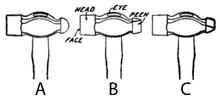Ball-peen hammer
A ball-peen (also spelled ball-pein[1]) hammer, also known as a machinist's hammer, is a type of peening hammer used in metalworking. It is distinguished from a cross-peen hammer, diagonal-peen hammer, point-peen hammer, or chisel-peen hammer by having a hemispherical head. It is commonly used as a tool for metalworking.
Uses
Though the process of peening (surface hardening by impact) has become rarer in metal fabrication, the ball-peen hammer remains useful for many tasks, such as striking punches and chisels (usually performed with the flat face of the hammer). The peening face is useful for rounding off edges of metal pins and fasteners, such as rivets. The ball face of the hammer can also be used to make gaskets for mating surfaces. A suitable gasket material is held over the surface where a corresponding gasket is desired, and the operator will lightly tap around the edges of the mating surface to perforate the gasket material.[2]
Variants

Variants include the straight-peen, diagonal-peen, and cross-peen hammer. These hammers have a wedge-shaped head instead of a ball-shaped head. This wedge shape spreads the metal perpendicular to the edge of the head. The straight-peen hammer has the wedge oriented parallel to the hammer's handle, while the cross-peen hammer's wedge is oriented perpendicular. The diagonal-peen hammer's head, as the name implies, is at a 45° angle from the handle. They are commonly used by blacksmiths during the forging process to deliver blows for forging or to strike other forging tools.
Head materials
Ball-peen hammer heads are typically made of heat treated forged high-carbon steel[3] or alloy steel; it is harder than the face of a claw hammer.[4] Softer brass heads are sometimes used.
Related soft-faced hammers have heads faced with materials such as brass, lead, tightly wound rawhide, or plastic, although these faces are usually flat, not in a ball or wedge peen shape. These hammers usually have replaceable heads or faces, because they will deform, wear out, or break over time. They are used to prevent damage to a struck surface,[5] and are graded by the weight of the head and by hardness of the striking face.
Notes
- ↑ Audel, Theodore (1962), Audels new mechanical dictionary for technical trades, Theodore Audel, p. 54.
- ↑ https://www.cteonline.org/curriculum/lessonplan/how-to-make-a-gasket-using-a-ball-peen-hammer-updated-by-ramon-c-iniguez/d2jo59
- ↑ Cavette, Chris, How hammer is made, retrieved 2008-12-19
- ↑ Benford, p. 36.
- ↑ Szykitka, p. 435.
References
- Benford, Tom (2006), Garage and Workshop Gear Guide, MotorBooks/MBI Publishing Company, ISBN 0-7603-2312-7.
- Szymborska, Walter (2004), The Big Book of Self-Reliant Living: Advice and Information on Just About Everything You Need to Know to Live on Planet Earth, Globe Pequot, ISBN 1-59228-043-9.